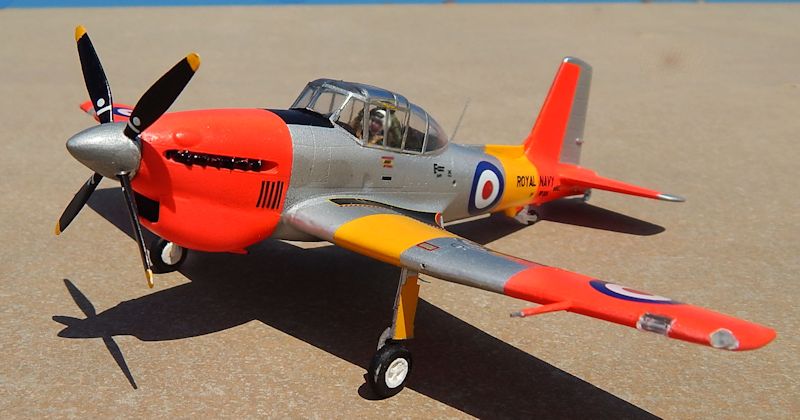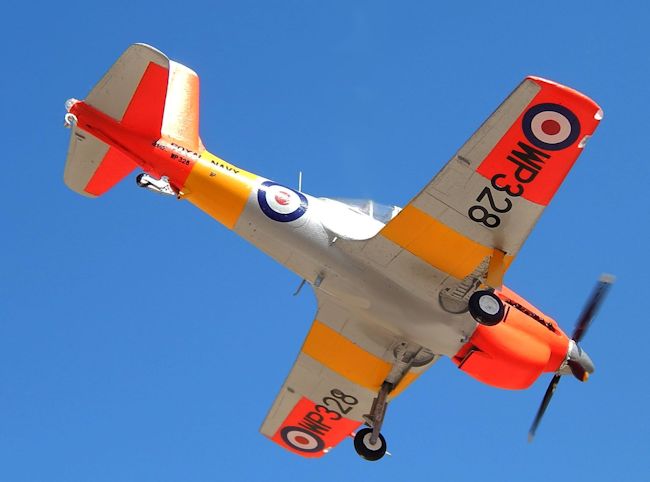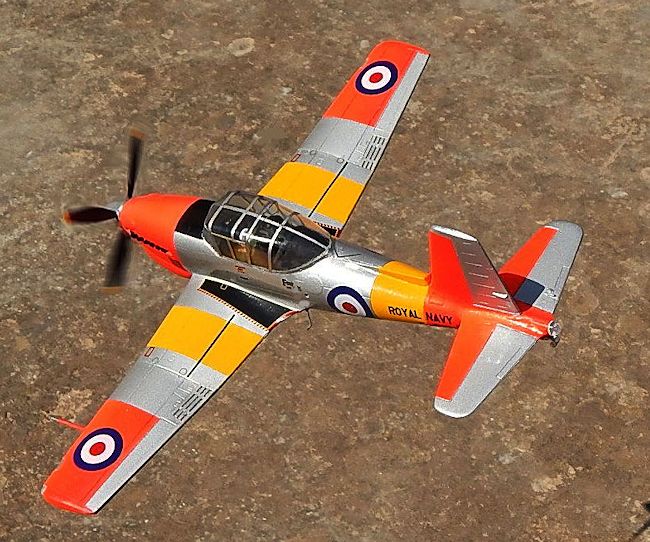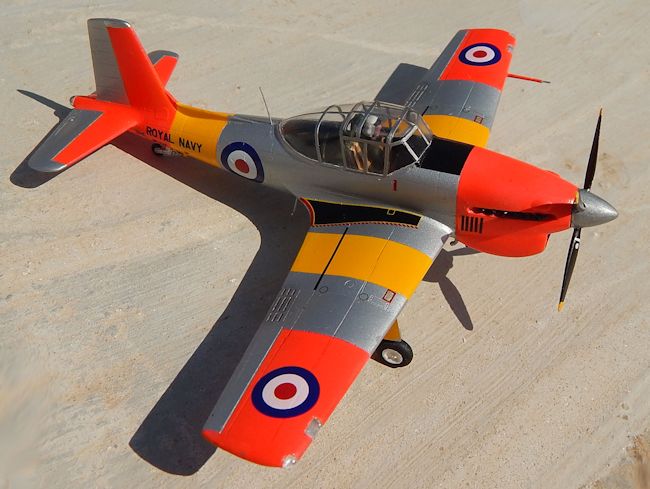Special Hobby 1/72 Sea Balliol T.21
|
KIT #: |
72236 |
|
PRICE: |
16 Euros |
|
DECALS: |
four options |
|
REVIEWER: |
Carmel J. Attard |
|
NOTES: |
Includes photo etch and resin parts |

 The Sea Balliol is an offshoot of the Balliol once used by the RAF. It was so
modified to be capable of landing on carrier decks. Deck landing trials were in
fact carried out aboard the HMS Illustrious in November 1950. That was followed
by Sea Balliols VR596 and VR599 that were fitted with arrestor hooks. VR549 was
fully modified and undertook trials on board the Illustrious in June 1953. 30 of
the type were supplied to the Royal Navy.
The Sea Balliol is an offshoot of the Balliol once used by the RAF. It was so
modified to be capable of landing on carrier decks. Deck landing trials were in
fact carried out aboard the HMS Illustrious in November 1950. That was followed
by Sea Balliols VR596 and VR599 that were fitted with arrestor hooks. VR549 was
fully modified and undertook trials on board the Illustrious in June 1953. 30 of
the type were supplied to the Royal Navy.
There was only one export order received for 12 land based Balliols. It
was a time when the world was full of cheap T-6 Harvards/ Texans available being
the principal reason. More ‘history’ about this aircraft appears in another
review of same type that was released by Pegasus.
When
I came across the Special Hobby Kit of the Boulton Paul Sea Balliol T-21 I was
at the time looking for something colorful and indeed it was as one of the
liveries offered included a particular old style color scheme of silver and
yellow trainer bands finish in combination with the later day glow orange areas
as if the finish of one particular aircraft was captured during the transition
period where FAA and RAF trainer types were switching over to a new style of
day glow era of trainer finish.
 This more conspicuous trainer livery fell on Sea Balliol with
registration WP328. Being a more recent kit release this appeared to contain
lots of detail parts as compared with the previous Sea Balliol kit that I
happened to build, the one issued by Pegasus. Upon opening the box there one
finds a 9-page kit instructions that contained a lot of detail of kit parts
complete with tiny cockpit and undercarriage detail parts I brass etch as well
as resin crew seats, column, radiator, folding wing detailed bracket ends and
consoles. This was in addition to the 41 or so injection molded parts in gray
styrene, a very clear canopy with embossed frame and a detailed decal sheet
covering four different trainer aircraft markings, one of which decorates a
colorful box art cover. An alternative smaller tail wheel is also included which
is a good reason to believe that SH had a RAF Balliol in mind for release in due
course.
This more conspicuous trainer livery fell on Sea Balliol with
registration WP328. Being a more recent kit release this appeared to contain
lots of detail parts as compared with the previous Sea Balliol kit that I
happened to build, the one issued by Pegasus. Upon opening the box there one
finds a 9-page kit instructions that contained a lot of detail of kit parts
complete with tiny cockpit and undercarriage detail parts I brass etch as well
as resin crew seats, column, radiator, folding wing detailed bracket ends and
consoles. This was in addition to the 41 or so injection molded parts in gray
styrene, a very clear canopy with embossed frame and a detailed decal sheet
covering four different trainer aircraft markings, one of which decorates a
colorful box art cover. An alternative smaller tail wheel is also included which
is a good reason to believe that SH had a RAF Balliol in mind for release in due
course.
There are 8 stages of construction, starting with cockpit interior
assembly that included a cockpit floor, two consoles adjacent to the seats; two
control columns, rudder pedals, instruments and decals for it. T he seats have
separate brass straps and bracket at back of seat. Once the canopy has been
assembled, painted and I also added a crew figure from my spares box, the rest
is almost a straightforward job. At one point one need to decide if the kit was
to be built with folded wings option and in this case the resin detailed end
brackets fitted at the wing sections need to be inserted. I still have space in
my showcases and decided to assemble the wings in lowered mode.
he seats have
separate brass straps and bracket at back of seat. Once the canopy has been
assembled, painted and I also added a crew figure from my spares box, the rest
is almost a straightforward job. At one point one need to decide if the kit was
to be built with folded wings option and in this case the resin detailed end
brackets fitted at the wing sections need to be inserted. I still have space in
my showcases and decided to assemble the wings in lowered mode.
The propeller comes with 4 separate loose blades but there is supplied a
hub end flange to which the blades are attached which makes assembly easy. Other
details such as separate exhaust manifolds, to which I drilled the port ends
open, landing light transparency, wing tip lights and brass etch aerials are all
supplied in detailed manner. Even
the windshield wipers are issued. I missed putting them on when I took the
pictures of the completed model. I added a pair of footsteps to fuselage roots
that show clearly on the box cover, these were made out of bent wires each
flattened at one end.
 The box cover artwork is very inspiring and my choice of colorscheme fell on
WP328 mentioned earlier. This was the most colorful of all 4 options. I first
masked the canopy that by now was in place, and gave the kit a coat of undercoat
white at areas to receive the yellow bands and day glow patches. This was
followed by air brushing Revell brand day glow oranges. Allowing this to dry,
masking applied and the trainer yellow bands carefully air brushed using Revell
trainer yellow paint. Again these band areas were masked with ‘Stuk’ precision
masking tape and the kit given an overall coat of commercial silver mix. I gave
the kit a coat of Future and applied the kit decals. Cockpit frame was made
using cut strips from ‘Tauro’ silver decal sheet.
The box cover artwork is very inspiring and my choice of colorscheme fell on
WP328 mentioned earlier. This was the most colorful of all 4 options. I first
masked the canopy that by now was in place, and gave the kit a coat of undercoat
white at areas to receive the yellow bands and day glow patches. This was
followed by air brushing Revell brand day glow oranges. Allowing this to dry,
masking applied and the trainer yellow bands carefully air brushed using Revell
trainer yellow paint. Again these band areas were masked with ‘Stuk’ precision
masking tape and the kit given an overall coat of commercial silver mix. I gave
the kit a coat of Future and applied the kit decals. Cockpit frame was made
using cut strips from ‘Tauro’ silver decal sheet.
The aircraft may be little known outside the UK in view of its short
service but definitely well known by enthusiasts who are keen on Royal Navy type
of aircraft. This was an enjoyable kit build and the impression is that the
livery was very effective in making the aircraft stand out in the sky during
a familiarization training flight way back in the early 1950s.
Carmel J.
Attard
July 2015
Copyright ModelingMadness.com. All rights reserved. No reproduction in any form without express permission from the editor.
If you would like your product reviewed fairly and fairly quickly, please
contact
the editor or see other details in the
Note to
Contributors.
Back to the Main Page
Back to the Review
Index Page


 The Sea Balliol is an offshoot of the Balliol once used by the RAF. It was so
modified to be capable of landing on carrier decks. Deck landing trials were in
fact carried out aboard the HMS Illustrious in November 1950. That was followed
by Sea Balliols VR596 and VR599 that were fitted with arrestor hooks. VR549 was
fully modified and undertook trials on board the Illustrious in June 1953. 30 of
the type were supplied to the Royal Navy.
The Sea Balliol is an offshoot of the Balliol once used by the RAF. It was so
modified to be capable of landing on carrier decks. Deck landing trials were in
fact carried out aboard the HMS Illustrious in November 1950. That was followed
by Sea Balliols VR596 and VR599 that were fitted with arrestor hooks. VR549 was
fully modified and undertook trials on board the Illustrious in June 1953. 30 of
the type were supplied to the Royal Navy.
 he seats have
separate brass straps and bracket at back of seat. Once the canopy has been
assembled, painted and I also added a crew figure from my spares box, the rest
is almost a straightforward job. At one point one need to decide if the kit was
to be built with folded wings option and in this case the resin detailed end
brackets fitted at the wing sections need to be inserted. I still have space in
my showcases and decided to assemble the wings in lowered mode.
he seats have
separate brass straps and bracket at back of seat. Once the canopy has been
assembled, painted and I also added a crew figure from my spares box, the rest
is almost a straightforward job. At one point one need to decide if the kit was
to be built with folded wings option and in this case the resin detailed end
brackets fitted at the wing sections need to be inserted. I still have space in
my showcases and decided to assemble the wings in lowered mode. The box cover artwork is very inspiring and my choice of colorscheme fell on
WP328 mentioned earlier. This was the most colorful of all 4 options. I first
masked the canopy that by now was in place, and gave the kit a coat of undercoat
white at areas to receive the yellow bands and day glow patches. This was
followed by air brushing Revell brand day glow oranges. Allowing this to dry,
masking applied and the trainer yellow bands carefully air brushed using Revell
trainer yellow paint. Again these band areas were masked with ‘Stuk’ precision
masking tape and the kit given an overall coat of commercial silver mix. I gave
the kit a coat of Future and applied the kit decals. Cockpit frame was made
using cut strips from ‘Tauro’ silver decal sheet.
The box cover artwork is very inspiring and my choice of colorscheme fell on
WP328 mentioned earlier. This was the most colorful of all 4 options. I first
masked the canopy that by now was in place, and gave the kit a coat of undercoat
white at areas to receive the yellow bands and day glow patches. This was
followed by air brushing Revell brand day glow oranges. Allowing this to dry,
masking applied and the trainer yellow bands carefully air brushed using Revell
trainer yellow paint. Again these band areas were masked with ‘Stuk’ precision
masking tape and the kit given an overall coat of commercial silver mix. I gave
the kit a coat of Future and applied the kit decals. Cockpit frame was made
using cut strips from ‘Tauro’ silver decal sheet.